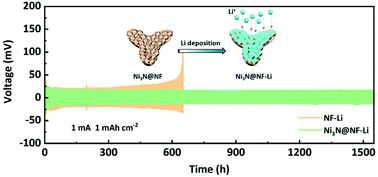Although lithium metal is regarded as the most promising anode for high energy density lithium ion batteries, the unstable solid–liquid interface during cycling severely shortens the battery lifetime. The Li deposition behavior is greatly influenced by the current density distribution on the surface of the electrode, which is significantly associated with the electrode structure. A well-designed electrode structure plays a key role in stabilizing the solid–liquid interface of the Li metal anode. In this work, a lithiophilic honeycomb-like Ni3N nanosheet array modified Ni foam (Ni3N@NF) is prepared to stabilize the lithium metal anode. The honeycomb-like Ni3N nanosheet arrays divide the surface of Ni foam into numerous micro-regions, enabling Li to independently deposit in each mesh. Besides, Li3N is generated resulting from the in situ reaction between Li and Ni3N, improving the transportation of Li-ions. Consequently, a symmetrical cell of Ni3N@NF–Li||Ni3N@NF–Li achieves stable Li plating/stripping behavior for over 1500 h at a current density of 1 mA cm−2. Besides, a full cell of Ni3N@NF–Li||LiFePO4 exhibits enhanced cycling stability and outstanding rate performance.

